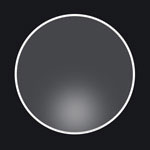When you work at a computer for any length of time, it's common to experience eye strain, blurred vision, red eyes and other symptoms of computer vision syndrome (CVS). This is because the visual demands of computer work are unlike those associated with most other activities. If you're under age 40, eye strain or blurred vision during computer work may be due to an inability of your eyes to remain accurately focused on your screen or because your eyes have trouble changing focus from your keyboard to your screen and back again for prolonged periods. This is also common among children. These focusing (accommodation) problems often are associated with CVS. If you're over age 40, the problem may be due to the onset of presbyopia — the normal age-related loss of near focusing ability. This, too, can cause CVS symptoms.
These lenses are specifically designed to relieve the symptoms of stress and visual fatigue from prolonged near and computer work. Classic symptoms associated with this condition are dry, burning stinging eyes. Constant rubbing of the eyes usually only exacerbates this condition. Soothing eye drops offer short term relief, but the symptoms persist with continued near work. Short breaks also offer some relief, but due to modern work demands, prolonged periods of near and computer work are unavoidable.
Single vision anti-fatigue lenses reduce the risk of eye strain, blurred vision and unnatural posture that can cause neck and back pain, and can be used comfortably by young and old computer users alike. For optimal performance, it is highly recommended to enhance these lenses with a high-quality anti reflective and blue control filter.
Types
There are typically 2 types of anti-fatigue lens designs
The lower addition lens is for younger adults, including students, or individuals, who may be suited to having less active support. Traditional computer screens are giving way to ever-smaller displays on tablets, eReaders, netbooks and smart phones. So now when we’re texting, tweeting, surfing, blogging, emailing, or playing, we’re putting more pressure than ever on our eyes. The imperceptible functional support shifts very gradually from distance refraction correction towards values up to half a diopter.
The higher addition lens is for early presbyopes (these are the 39 to 43 yr old group) who are not ready for a progressive solution. These are the typical office workers who are confined to computers for most of the day. The constant shifting of focus from far to near is taxing on the accommodative system and has been identified as a major contributor to CVS eyestrain. These lenses offer relief by assisting this process. The imperceptible functional support shifts very gradually from distance refraction correction towards values up to just over three quarters of a diopter.
Adaptation
There is always an Adaptation period for any new lenses, especially high-end lenses that are designed for a very specific purpose. In many cases this might be your first pair of spectacles. Minor peripheral distortions might be noted, and when looking at distant objects one might notice a slight “blurry” effect. This is normal, and should be less noticeable after 10 to 14 days. Some users experience a sensation of "swim" when you make quick head movements. It is normal for you to experience this when you start wearing a new pair of anti-fatigue lenses. You can reduce this effect by making very slight head movements to look more directly at objects on your desk or workstation.
Most people report that when wearing anti-fatigue lenses these issues are relatively mild and disappear as they adapt to wearing the lenses over a period of a few days. Be fair to yourself by giving yourself a few days to adapt to your new lenses
Materials
These lenses are only available in plastic material. Technological and chemical advancements have produced Plastic materials that are well suited to spectacle lenses The plastic material most commonly used is known as CR39 ( "Columbia Resin 39"). It is a thermal-cured plastic developed in the early 1940s. CR-39 plastic remains a popular material for spectacle lenses because of its light weight (about half the weight of glass), low cost and excellent optical qualities.
Polycarbonate Material developed in the early 1970s, is also used due to its incredible impact resistance. Polycarbonate lenses became increasing popular and remain so today. This material is used for helmet visors for the Air Force, for "bulletproof glass" for banks and other safety applications, polycarbonate is lighter and significantly more impact-resistant than CR-39 plastic, making it a good material for children's eyewear, safety glasses and sports eyewear.
A newer lightweight lens material with similar impact-resistant properties as polycarbonate called Trivex was introduced for eyewear in 2001. The advantage of this material is its superior optical properties compared to polycarbonate.
Refractive Index
The refractive index of lenses refers to the light bending properties of the specific material. The more “dense” the material, the higher the refractive index. For example, Air has a refractive index of 1. And pure water has a refractive index of 1.33, and the densest clear material known to man is a diamond, which has a refractive index of 2.4. the higher refractive index also means the specific material reflects light more, as the light cannot enter it easily due to the increased density of the material, that is why diamonds “sparkle” as they do because they reflect the light more.
The refractive index of plastic ranges from 1.498 (CR-39 plastic) to 1.74 (a specific variety of high-index plastic). So, for the same prescription power and lens design, a lens made of CR-39 plastic will be the thickest and a lens made in 1.74 index plastic will be the thinnest.
The higher index lenses on the downside tend to reflect light more, and for this reason it is essential to treat the surfaces of these lenses with an Anti-reflective coating.
Tints
Tints of virtually any color can be applied to lenses. Lighter tints are often used because these lenses are predominantly used in an office or classroom environment. The tints in these cases are often to just reduce the effect of flicker from fluorescent lights, or the slight flickering of the computer screen. Some users find relief from a slight tint when working in an office, specifically when using a computer most of the day. Color can be added to a lens as a solid tint, where the entire lens has the same color density, or as a gradient tint, where the color density is darkest at the top of the lens and gradually fades to clear or nearly clear at the bottom.
Different colors can be applied to lenses for different purposes. Green, Blue, Green/grey, Grey, Soft Pink and Brown tints used in varying densities depending on user preference, are the most popular for these lenses.
Coatings
Cumulative exposure to the sun's harmful ultraviolet (UV) radiation over a person's lifetime has been associated with age-related eye problems including cataracts and macular degeneration. CRT monitors are also known to emit harmful ultraviolet rays.
For this reason, people should protect their eyes from UV beginning in early childhood.
An ultraviolet protective coating can be applied to plastic lenses to block out the harmful Ultraviolet rays. Polycarbonate and nearly all high-index plastic lenses have 100 percent UV protection built-in, due to absorptive characteristics of the lens material. Anti-reflective coating (also called "AR coating" or "anti-glare coating") improves vision, reduces eye strain and makes your spectacles look more attractive. These benefits are due to the ability of AR coating to virtually eliminate reflections from the front and back surfaces of your lenses. With reflections gone, more light passes through your lenses to optimize your vision with fewer reflections and ghost images. Apart from the optical benefits, this enhances your appearance by drawing more attention to your eyes and helping you make better "eye contact" with others.
Blue Control coatings are also recommended for these lenses, as research has shown that blue light can be a major factor and contributor to fatigue associated with continued computer use. This type of lens coating is referred to as a blue light filter coating. Thanks to blue light filter coatings, the harmful portion of blue light is cut while allowing the good portion of blue light to pass through. You can actually see the protection at work as blue light is being reflected off the lens. Due to the reduced amount of blue light entering the eyes, contrasts are improved by reducing screen brightness, flickering and eye fatigue to provide a strain-free visual experience while providing the most complete protection. Apart from the blue control filter coating, one should routinely take a short break every hour if your work situation requires extended periods of continuous computer use.
All lightweight plastic lens materials have surfaces that are significantly softer and more prone to scratches and abrasions than glass lenses. Polycarbonate is the softest lens material, but is also the most impact-resistant. All plastic and high-index plastic lenses require a factory-applied anti-scratch coating for adequate lens durability. Most of today's modern anti-scratch coatings (also called scratch coats or hard coats) can make your lenses nearly as scratch-resistant as glass.


